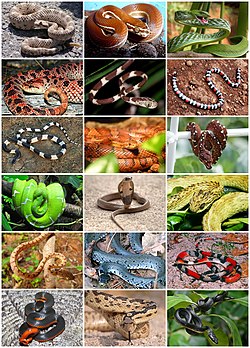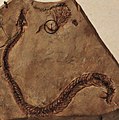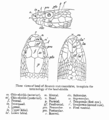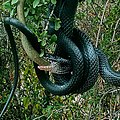The Snake Portal Snakes are elongated, limbless, carnivorous reptiles of the suborder Serpentes ( /sɜːrˈpɛntiːz/). Like all other squamates, snakes are ectothermic, amniote vertebrates covered in overlapping scales. Many species of snakes have skulls with several more joints than their lizard ancestors, enabling them to swallow prey much larger than their heads ( cranial kinesis). To accommodate their narrow bodies, snakes' paired organs (such as kidneys) appear one in front of the other instead of side by side, and most have only one functional lung. Some species retain a pelvic girdle with a pair of vestigial claws on either side of the cloaca. Lizards have independently evolved elongate bodies without limbs or with greatly reduced limbs at least twenty-five times via convergent evolution, leading to many lineages of legless lizards. These resemble snakes, but several common groups of legless lizards have eyelids and external ears, which snakes lack, although this rule is not universal (see Amphisbaenia, Dibamidae, and Pygopodidae). Living snakes are found on every continent except Antarctica, and on most smaller land masses; exceptions include some large islands, such as Ireland, Iceland, Greenland, the Hawaiian archipelago, and the islands of New Zealand, as well as many small islands of the Atlantic and central Pacific oceans. Additionally, sea snakes are widespread throughout the Indian and Pacific oceans. Around thirty families are currently recognized, comprising about 520 genera and about 3,900 species. They range in size from the tiny, 10.4 cm-long (4.1 in) Barbados threadsnake to the reticulated python of 6.95 meters (22.8 ft) in length. The fossil species Titanoboa cerrejonensis was 12.8 meters (42 ft) long. Snakes are thought to have evolved from either burrowing or aquatic lizards, perhaps during the Jurassic period, with the earliest known fossils dating to between 143 and 167 Ma ago. The diversity of modern snakes appeared during the Paleocene epoch ( c. 66 to 56 Ma ago, after the Cretaceous–Paleogene extinction event). The oldest preserved descriptions of snakes can be found in the Brooklyn Papyrus. ( Full article...) Selected article - The king brown snake (Pseudechis australis) is a species of highly venomous snake of the family Elapidae, native to northern, western, and Central Australia. The king brown snake is the largest terrestrial venomous snake in Australia. Despite its common name, it is a member of the genus Pseudechis (black snakes) and only distantly related to true brown snakes. Its alternative common name is the mulga snake, although it lives in many habitats apart from mulga. First described by English zoologist John Edward Gray in 1842, it is a robust snake up to 3.3 m (11 ft) long. It is variable in appearance, with individuals from northern Australia having tan upper parts, while those from southern Australia are dark brown to blackish. Sometimes, it is seen in a reddish-green texture. The dorsal scales are two-toned, sometimes giving the snake a patterned appearance. Its underside is cream or white, often with orange splotches. The species is oviparous. The snake is considered to be a least-concern species according to the International Union for Conservation of Nature, though may have declined with the spread of the cane toad. Its venom is not as potent as those of Australia's other dangerous snakes, but can still cause severe effects if delivered in large enough quantities. Its main effect is on striated muscle tissue, causing paralysis from muscle damage, and also commonly affects blood clotting ( coagulopathy). Often, extensive pain and swelling occur, rarely with necrosis, at the bite site. Deaths from its bites have been recorded, with the most recent being in 1969. Its victims are treated with black snake (not brown snake) antivenom. ( Full article...)Did you know (auto-generated) -
More did you know? -
Quality ContentFeatured snake-related articles -
George Went Hensley -
List of snakes of Trinidad and Tobago Good snake-related articles - Agkistrodon piscivorus - Bitis arietans - Bitis gabonica - Black mamba - Black-necked spitting cobra - Eastern green mamba - Forest cobra - Hydrophiinae - Many-banded krait - Nerodia clarkii - Russell's viper - Snake scales - Vipera berus - Western green mamba TopicsLists -
List of snakes by common name -
List of Serpentes families -
List of snake genera -
List of dangerous snakes
Families -
Acrochordidae -
Aniliidae -
Anomochilidae -
Boidae -
Bolyeriidae -
Colubridae -
Cylindrophiidae -
Elapidae -
Loxocemidae -
Pythonidae -
Tropidophiidae -
Uropeltidae -
Viperidae -
Xenopeltidae -
Anomalepididae -
Leptotyphlopidae -
Typhlopidae Anatomy and physiology -
Infrared sensing in snakes -
Pelvic spur -
Snake scales -
Snake skeleton SubcategoriesRelated portalsNeed help?Do you have a question about Snakes that you can't find the answer to? Consider asking it at the Wikipedia reference desk. Snakes in the newsNo recent news Things you can do
Help at WikiProjects:
Associated WikimediaThe following Wikimedia Foundation sister projects provide more on this subject:
Discover Wikipedia using
portals |
The Snake Portal Snakes are elongated, limbless, carnivorous reptiles of the suborder Serpentes ( /sɜːrˈpɛntiːz/). Like all other squamates, snakes are ectothermic, amniote vertebrates covered in overlapping scales. Many species of snakes have skulls with several more joints than their lizard ancestors, enabling them to swallow prey much larger than their heads ( cranial kinesis). To accommodate their narrow bodies, snakes' paired organs (such as kidneys) appear one in front of the other instead of side by side, and most have only one functional lung. Some species retain a pelvic girdle with a pair of vestigial claws on either side of the cloaca. Lizards have independently evolved elongate bodies without limbs or with greatly reduced limbs at least twenty-five times via convergent evolution, leading to many lineages of legless lizards. These resemble snakes, but several common groups of legless lizards have eyelids and external ears, which snakes lack, although this rule is not universal (see Amphisbaenia, Dibamidae, and Pygopodidae). Living snakes are found on every continent except Antarctica, and on most smaller land masses; exceptions include some large islands, such as Ireland, Iceland, Greenland, the Hawaiian archipelago, and the islands of New Zealand, as well as many small islands of the Atlantic and central Pacific oceans. Additionally, sea snakes are widespread throughout the Indian and Pacific oceans. Around thirty families are currently recognized, comprising about 520 genera and about 3,900 species. They range in size from the tiny, 10.4 cm-long (4.1 in) Barbados threadsnake to the reticulated python of 6.95 meters (22.8 ft) in length. The fossil species Titanoboa cerrejonensis was 12.8 meters (42 ft) long. Snakes are thought to have evolved from either burrowing or aquatic lizards, perhaps during the Jurassic period, with the earliest known fossils dating to between 143 and 167 Ma ago. The diversity of modern snakes appeared during the Paleocene epoch ( c. 66 to 56 Ma ago, after the Cretaceous–Paleogene extinction event). The oldest preserved descriptions of snakes can be found in the Brooklyn Papyrus. ( Full article...) Selected article - The king brown snake (Pseudechis australis) is a species of highly venomous snake of the family Elapidae, native to northern, western, and Central Australia. The king brown snake is the largest terrestrial venomous snake in Australia. Despite its common name, it is a member of the genus Pseudechis (black snakes) and only distantly related to true brown snakes. Its alternative common name is the mulga snake, although it lives in many habitats apart from mulga. First described by English zoologist John Edward Gray in 1842, it is a robust snake up to 3.3 m (11 ft) long. It is variable in appearance, with individuals from northern Australia having tan upper parts, while those from southern Australia are dark brown to blackish. Sometimes, it is seen in a reddish-green texture. The dorsal scales are two-toned, sometimes giving the snake a patterned appearance. Its underside is cream or white, often with orange splotches. The species is oviparous. The snake is considered to be a least-concern species according to the International Union for Conservation of Nature, though may have declined with the spread of the cane toad. Its venom is not as potent as those of Australia's other dangerous snakes, but can still cause severe effects if delivered in large enough quantities. Its main effect is on striated muscle tissue, causing paralysis from muscle damage, and also commonly affects blood clotting ( coagulopathy). Often, extensive pain and swelling occur, rarely with necrosis, at the bite site. Deaths from its bites have been recorded, with the most recent being in 1969. Its victims are treated with black snake (not brown snake) antivenom. ( Full article...)Did you know (auto-generated) -
More did you know? -
Quality ContentFeatured snake-related articles -
George Went Hensley -
List of snakes of Trinidad and Tobago Good snake-related articles - Agkistrodon piscivorus - Bitis arietans - Bitis gabonica - Black mamba - Black-necked spitting cobra - Eastern green mamba - Forest cobra - Hydrophiinae - Many-banded krait - Nerodia clarkii - Russell's viper - Snake scales - Vipera berus - Western green mamba TopicsLists -
List of snakes by common name -
List of Serpentes families -
List of snake genera -
List of dangerous snakes
Families -
Acrochordidae -
Aniliidae -
Anomochilidae -
Boidae -
Bolyeriidae -
Colubridae -
Cylindrophiidae -
Elapidae -
Loxocemidae -
Pythonidae -
Tropidophiidae -
Uropeltidae -
Viperidae -
Xenopeltidae -
Anomalepididae -
Leptotyphlopidae -
Typhlopidae Anatomy and physiology -
Infrared sensing in snakes -
Pelvic spur -
Snake scales -
Snake skeleton SubcategoriesRelated portalsNeed help?Do you have a question about Snakes that you can't find the answer to? Consider asking it at the Wikipedia reference desk. Snakes in the newsNo recent news Things you can do
Help at WikiProjects:
Associated WikimediaThe following Wikimedia Foundation sister projects provide more on this subject:
Discover Wikipedia using
portals |



























































